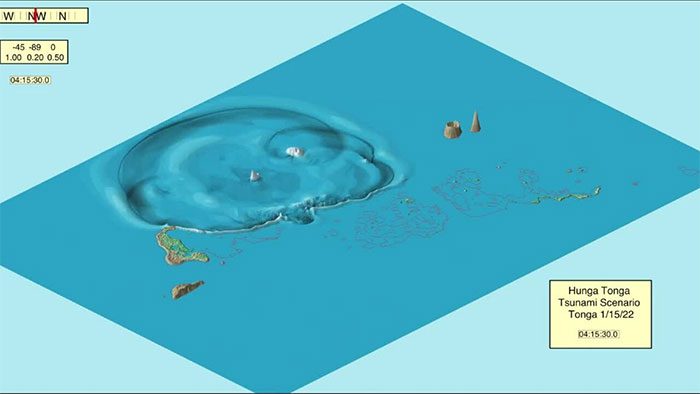The underwater volcanic eruption in Tonga in 2022 generated a mega tsunami and released energy equivalent to 20 million tons of TNT.
Simulation of the tsunami spread in Tonga. (Video: Steven N. Ward/University of California Santa Cruz).
According to new research from a team of scientists at the Rosenstiel School of Marine and Atmospheric Science at the University of Miami and the Khaled bin Sultan Living Oceans Foundation (KSLOF), the underwater volcanic eruption in Tonga in 2022 was more powerful than the largest nuclear explosion conducted by the United States, Phys reported on April 15. The new study was published in the journal Science Advances.
The eruption of the Hunga Tonga-Hunga Ha’apai (HTHH) volcano released energy equivalent to 20 million tons of TNT across five explosions, with the most powerful explosion estimated at 15 million tons. This magnitude is still less than the Tsar Bomba, the largest nuclear bomb ever tested, but far exceeds the largest American bomb – the B83, which has a yield equivalent to 1.2 million tons of TNT. The 2022 disaster was also stronger than the eruption of Mount Pinatubo in 1991, which holds the record for the largest eruption since 1912.
The explosive eruption of HTHH in 2022 generated a mega tsunami with waves reaching heights of up to 45 meters along the coast of Tofua Island and waves as high as 17 meters at Tongatapu – Tonga’s most populated island.
In the new study, the team of experts used a combination of satellite imagery, drone maps, field observations collected by scientists from the University of Auckland, and data from the Global Coral Reef Expedition Program (KSLOF) to create a tsunami simulation in Tonga. The results showed that the complex topography of the area acted as a trap for low-speed waves, creating a tsunami that lasted over an hour with waves reaching heights of 85 meters approximately one minute after the initial explosion.

This volcanic eruption released energy equivalent to 20 million tons of TNT.
The HTHH submarine eruption can be compared to the Krakatoa eruption in 1883, which resulted in over 36,000 fatalities. “Despite its large scale and duration, the HTHH mega tsunami claimed very few lives. We believe that the key factors contributing to this are the unusual location, the COVID-19 pandemic (which reduced tourist numbers), evacuation drills, and increased awareness efforts in Tonga in the years leading up to the eruption,” explained Professor Sam Purkis, chair of the Department of Marine Geology at the Rosenstiel School.
The simulation also indicated that the location of the eruption in relation to urban centers helped mitigate the impact. Only six direct fatalities have been confirmed from the HTHH disaster.
“The 2022 event may have been a fortunate escape, but other submarine volcanoes have the potential to generate tsunamis of similar magnitude in the future,” Purkis noted.
“The eruption provides many important lessons regarding tsunamis, both in the past and future, in Tonga and elsewhere. The eruption serves as a great ‘natural laboratory’ to test hypotheses and models that can be applied elsewhere, helping to better prepare for future disasters and gain a deeper understanding of similar eruptions and tsunamis,” he added.


















































